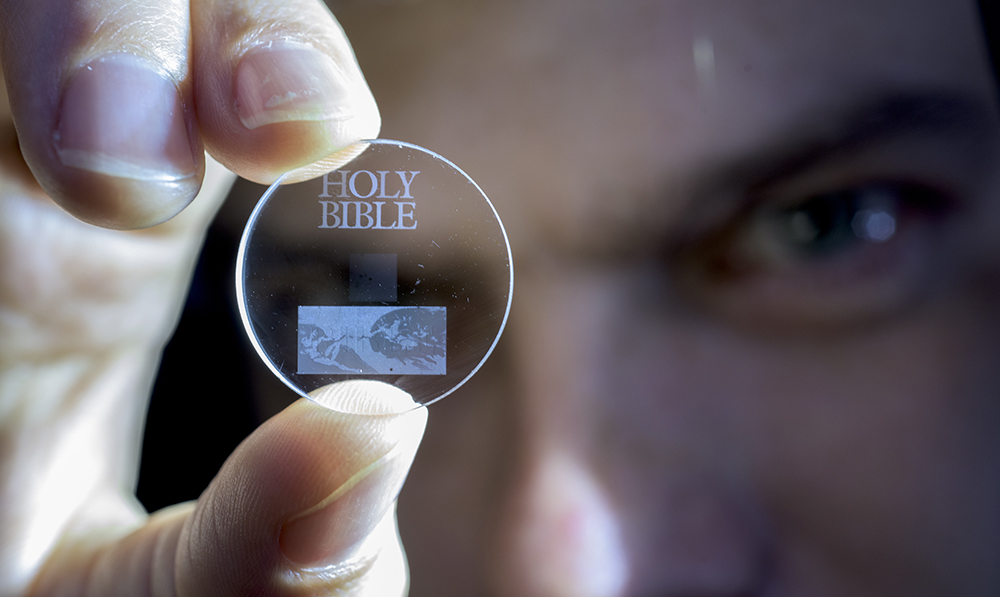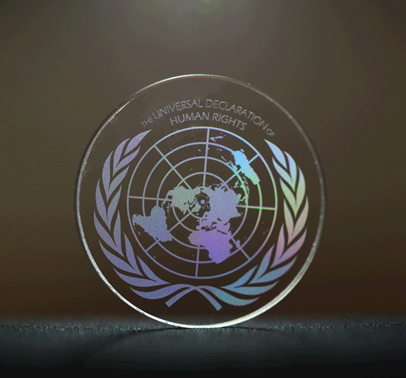360TB glass disc will preserve human history for “billions of years”
Coin-sized medium is also capable of withstanding intense heat

A revolutionary storage medium, capable of holding 360TB of data and withstanding extreme temperatures, will allow humanity's life and works to survive for "billons of years", its creators say.
Scientists from the University of Southampton's Optoelectronics Research Centre (ORC) have referred to the breakthrough technology, which uses nanostructured glass, as being akin to the memory crystals seen in Superman.
Known as 5D, the medium takes its name from the process of five dimensional digital recording that allows information to be stored on specially created glass by femtosecond laser writing.
The scientists say their ultra-compact technology has a thermal stability up to 1,000C, which at room temperature gives it a "virtually unlimited lifetime".
The prototype shown above measures just 25mm in diameter smaller than a 2 coin (28.4mm). Speaking to IT Pro, ORC team member and PhD student Ausra Cerkauskaite said the researchers would look to produce a standard-sized optical disc (12cm), which would then "ultimately fit about 360TB" more than 7,000 times a 50GB double-layer Blu-ray disc.
"Despite all technological progress it is still difficult to securely store large amounts of information over even relatively short timescales of 100 years. Our solution allows completely eliminating this problem. And this does fascinate us," Cerkauskaite said.

5D could be the start for a new era of colossal data archiving. The team at the ORC believes its technology could be highly useful for national archives, museums and libraries to preserve their records, photos and other documents.
Get the ITPro daily newsletter
Sign up today and you will receive a free copy of our Future Focus 2025 report - the leading guidance on AI, cybersecurity and other IT challenges as per 700+ senior executives
The researchers first demonstrated an experimental version of the technology in 2013 when a 300KB digital copy of a text file was successfully recorded in 5D.
Now, they have managed to write historical and cultural work such as the Universal Declaration of Human Rights (UDHR), Newton's seminal work Opticks, the Magna Carta and the King James Bible to 5D.
"It is thrilling to think that we have created the technology to preserve documents and information and store it in space for future generations," said professor Peter Kazansky, from the ORC. "This technology can secure the last evidence of our civilisation: all we've learnt will not be forgotten."
The researchers are due to present their findings at SPIE Photonics West, an international optical engineering conference in San Francisco, this week.
The team is now looking for industry partners to further develop and commercialise the technology.
Cerkauskaite told IT Pro: "Our main goals now are to improve the speed of writing and develop the technology of microscope-free read-out drive that would increase the impact towards the realisation as mass-market technology."
Images: University of Southampton, Optoelectronics Research Centre
-
 Work and innovate everywhere
Work and innovate everywherewhitepaper Protection across AI attack vectors
By ITPro
-
 The future of outstanding power efficiency
The future of outstanding power efficiencywhitepaper An essential guide to help determine a clear path to power effiency, robust data security, and best in-class versatility
By ITPro
-
 Cyber-resilient data storage for everyone
Cyber-resilient data storage for everyoneWhitepaper Improve cyber resilience and optimize performance
By ITPro
-
 Sustainability is more than a flash-in-the-pan topic for the data storage industry
Sustainability is more than a flash-in-the-pan topic for the data storage industryAnalysis Rising energy costs and concerns over the environmental impact of data centers are prompting a shift away from power-hungry disk drives
By Ross Kelly
-
 Dell Technologies World 2023: AI and storage to take center stage
Dell Technologies World 2023: AI and storage to take center stageAnalysis Energy efficiency and intelligent systems are likely to play key roles at Dell’s biggest ever annual conference
By Rory Bathgate
-
 The Total Economic Impact™ Of IBM FlashSystem
The Total Economic Impact™ Of IBM FlashSystemWhitepaper Cost savings and business benefits enabled by FlashSystem
By ITPro
-
 HPE Primera A630 review: 100% storage uptime with no excuses
HPE Primera A630 review: 100% storage uptime with no excusesReviews A powerful all-Flash array that ticks all the right boxes for Tier-0 storage
By Dave Mitchell
-
 The smart buyer’s guide to flash
The smart buyer’s guide to flashWhitepaper Find out whether flash storage is right for your business
By ITPro

